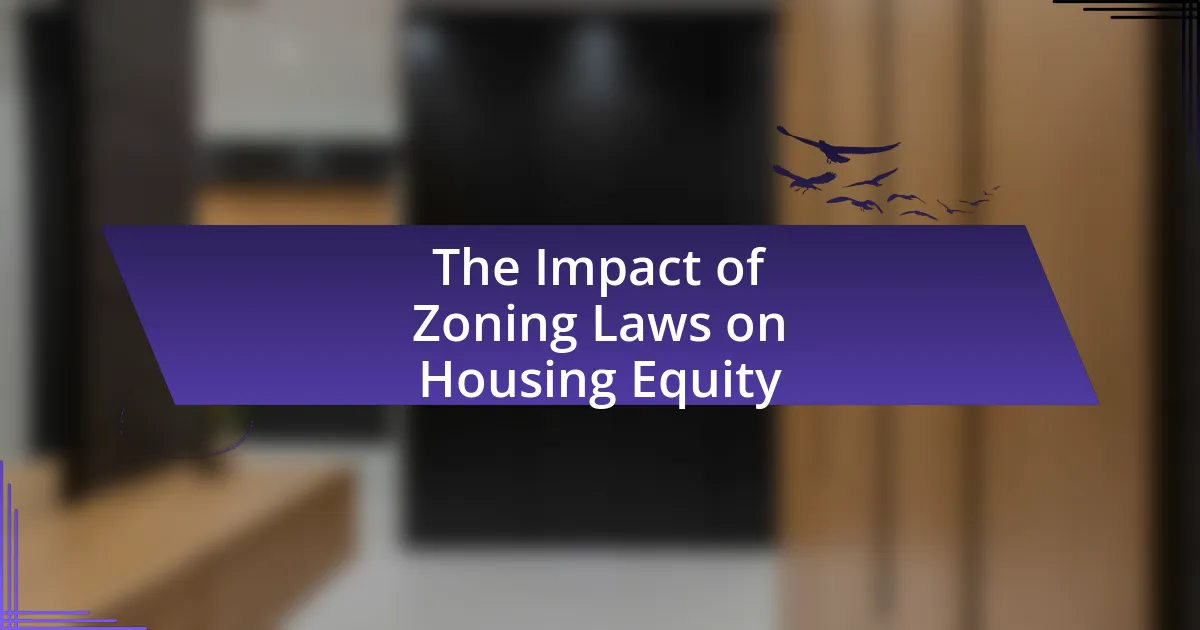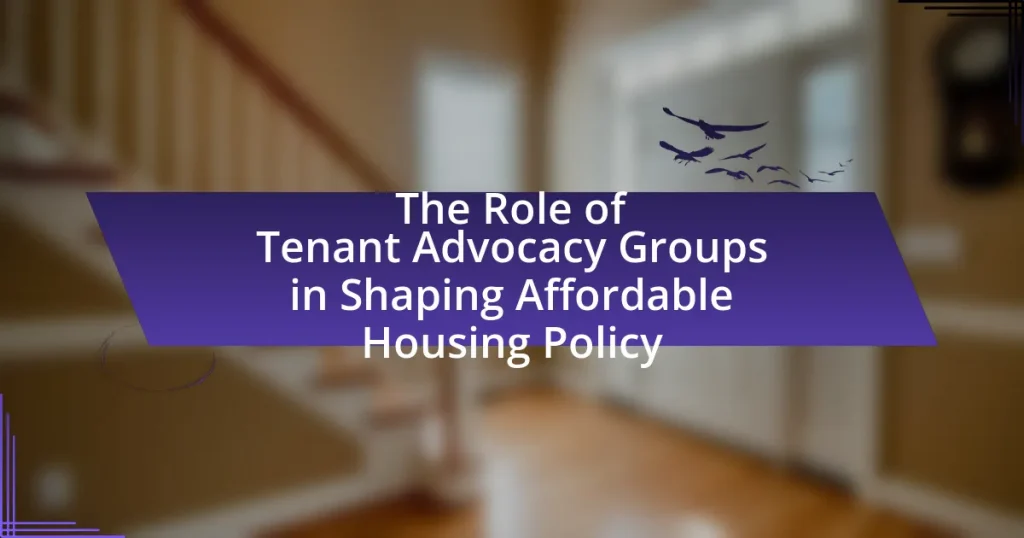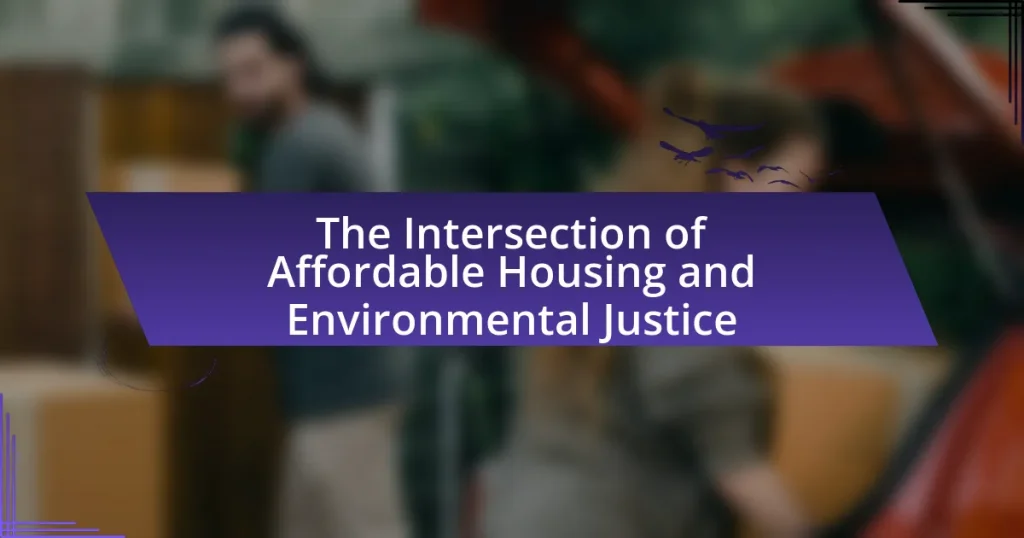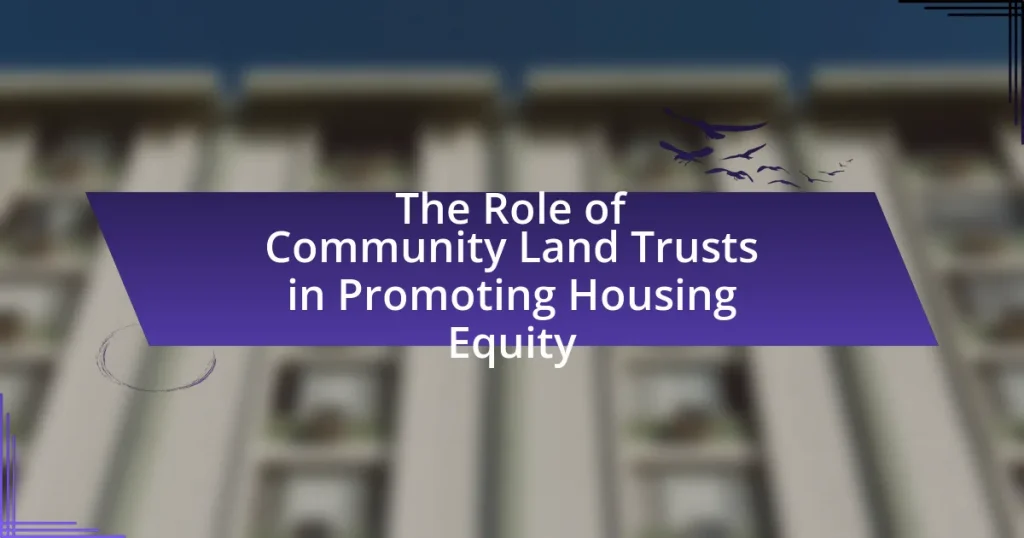Zoning laws are regulations set by local governments that dictate land use in specific areas, playing a crucial role in urban planning and housing equity. These laws can either promote or hinder affordable housing by determining the types of developments allowed, which directly impacts the availability and affordability of housing for various income levels. The article explores the different types of zoning classifications, the influence of zoning on community demographics, and the challenges faced in reforming these laws to enhance housing equity. It also highlights the importance of inclusive zoning practices and collaborative efforts among stakeholders to address housing disparities and improve access to affordable housing for marginalized communities.
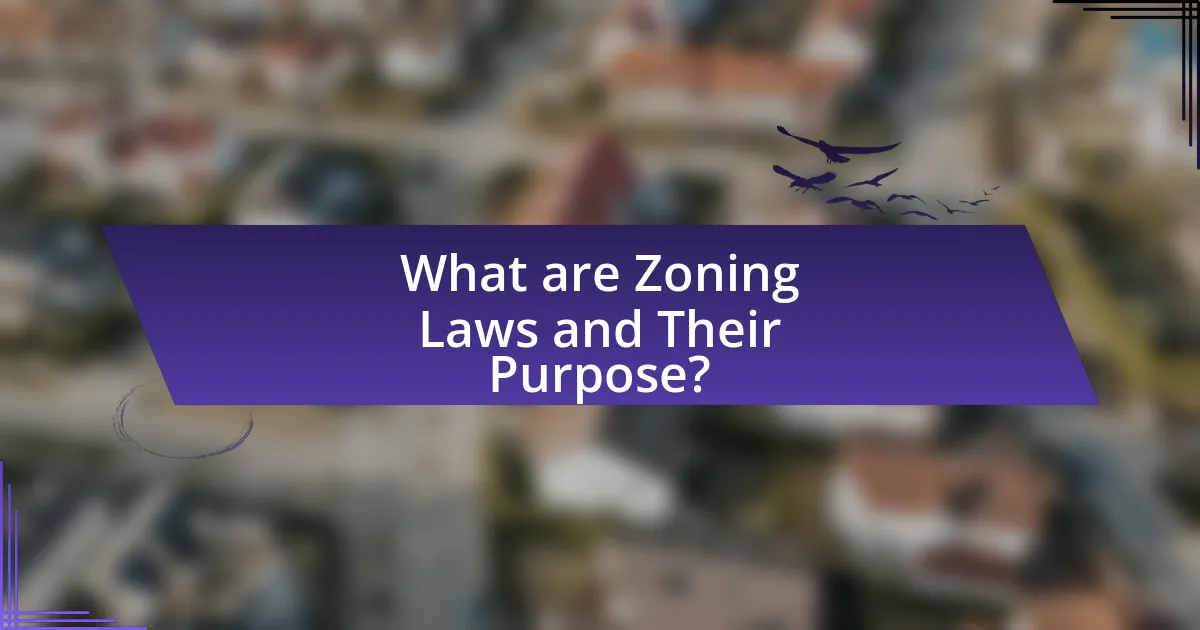
What are Zoning Laws and Their Purpose?
Zoning laws are regulations established by local governments that dictate how land can be used in specific areas. Their primary purpose is to organize urban development, ensuring that land use is compatible with surrounding areas, which helps to promote public health, safety, and welfare. For instance, zoning laws can separate residential areas from industrial zones to minimize conflicts between different land uses, thereby enhancing community quality of life. Additionally, these laws can influence housing equity by determining the types of housing that can be built, which affects availability and affordability for various income levels.
How do zoning laws influence urban planning?
Zoning laws significantly influence urban planning by regulating land use, density, and the types of buildings permitted in specific areas. These regulations shape the physical layout of cities, determining where residential, commercial, and industrial developments can occur. For instance, zoning can restrict high-density housing in certain neighborhoods, which can lead to housing shortages and increased prices, impacting housing equity. Studies have shown that restrictive zoning practices contribute to socioeconomic segregation, as they limit affordable housing options in desirable areas, thereby exacerbating inequalities in access to resources and opportunities.
What are the different types of zoning classifications?
Zoning classifications are categories that determine how land can be used and developed. The primary types of zoning classifications include residential, commercial, industrial, agricultural, and mixed-use. Residential zoning is designated for housing, commercial zoning is for businesses, industrial zoning is for manufacturing and production, agricultural zoning is for farming activities, and mixed-use zoning allows for a combination of residential and commercial uses. These classifications are essential for urban planning and can significantly influence housing equity by affecting the availability and affordability of housing options in different areas.
How do zoning laws affect land use and development?
Zoning laws significantly influence land use and development by regulating how land can be utilized, which in turn shapes community growth and housing availability. These laws dictate the types of buildings that can be constructed in specific areas, such as residential, commercial, or industrial uses, thereby controlling density, building height, and the overall character of neighborhoods. For instance, a study by the Lincoln Institute of Land Policy found that restrictive zoning can limit housing supply, contributing to increased housing costs and reduced affordability, particularly in urban areas. This regulatory framework directly impacts housing equity by either facilitating or hindering access to affordable housing options for diverse populations.
Why are zoning laws important for housing equity?
Zoning laws are important for housing equity because they regulate land use and development, directly influencing the availability and affordability of housing. By establishing parameters for where different types of housing can be built, zoning laws can either promote inclusive communities or reinforce segregation. For instance, exclusionary zoning practices, such as minimum lot sizes or single-family zoning, can limit affordable housing options, disproportionately affecting low-income and marginalized groups. Research indicates that areas with more inclusive zoning policies tend to have greater access to affordable housing, which is essential for fostering diverse and equitable communities.
What role do zoning laws play in shaping community demographics?
Zoning laws significantly influence community demographics by regulating land use, which affects housing availability and affordability. These laws can create barriers to entry for low-income families by designating certain areas for high-density housing or restricting development in affluent neighborhoods. For instance, exclusionary zoning practices, such as minimum lot sizes and single-family zoning, can limit the construction of affordable housing, thereby perpetuating socioeconomic segregation. Research from the National Low Income Housing Coalition indicates that restrictive zoning contributes to a shortage of affordable housing, disproportionately impacting marginalized communities and reinforcing existing demographic divides.
How can zoning laws contribute to or hinder affordable housing?
Zoning laws can significantly hinder affordable housing by imposing restrictions that limit the types and densities of housing that can be built. For example, single-family zoning often prevents the construction of multi-family units, which are typically more affordable. According to a report by the National Low Income Housing Coalition, restrictive zoning contributes to a shortage of affordable housing, with an estimated 7 million more affordable rental homes needed for low-income households in the United States. Conversely, zoning laws can contribute to affordable housing by allowing for higher density developments and mixed-use zoning, which can increase the supply of housing and lower costs. Cities that have adopted inclusionary zoning policies, which require a percentage of new developments to be affordable, have seen positive impacts on housing equity.
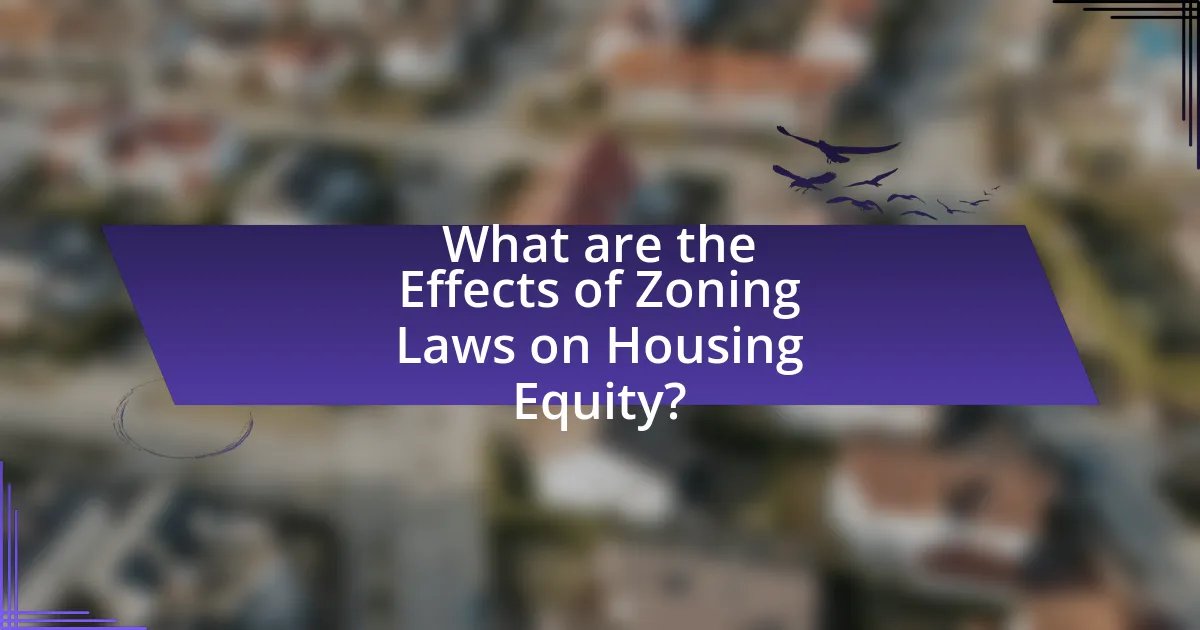
What are the Effects of Zoning Laws on Housing Equity?
Zoning laws significantly affect housing equity by regulating land use and determining the types of housing that can be built in specific areas. These regulations often lead to the exclusion of affordable housing options, which disproportionately impacts low-income and marginalized communities. For instance, a study by the National Low Income Housing Coalition found that restrictive zoning practices contribute to a shortage of affordable housing, exacerbating economic disparities. Additionally, zoning laws can perpetuate segregation by favoring single-family homes in affluent neighborhoods, limiting access for lower-income families. This creates barriers to wealth accumulation and social mobility, ultimately undermining housing equity.
How do zoning laws impact marginalized communities?
Zoning laws significantly impact marginalized communities by restricting access to affordable housing and perpetuating segregation. These regulations often favor higher-income developments, limiting the availability of low-cost housing options in desirable areas. For instance, a study by the National Community Reinvestment Coalition found that exclusionary zoning practices contribute to a lack of affordable housing in urban centers, disproportionately affecting low-income and minority populations. Additionally, zoning laws can restrict the types of housing that can be built, such as multifamily units, which are essential for accommodating diverse income levels. This creates barriers for marginalized communities seeking stable housing and exacerbates existing inequalities in access to resources and opportunities.
What evidence exists linking zoning laws to housing disparities?
Zoning laws significantly contribute to housing disparities by regulating land use and determining the types of housing that can be built in specific areas. Research indicates that exclusionary zoning practices, such as minimum lot sizes and single-family zoning, restrict the availability of affordable housing options, leading to increased housing costs and segregation. For instance, a study by the National Bureau of Economic Research found that restrictive zoning contributes to a 20% increase in housing prices in metropolitan areas, disproportionately affecting low-income families and communities of color. Additionally, the American Planning Association highlights that areas with stringent zoning regulations often experience lower rates of housing development, exacerbating the housing crisis and limiting access to diverse housing types.
How do exclusionary zoning practices affect low-income families?
Exclusionary zoning practices negatively impact low-income families by limiting their access to affordable housing options. These zoning laws often impose restrictions such as minimum lot sizes, prohibitions on multi-family units, and high building costs, which effectively exclude lower-income households from certain neighborhoods. For instance, a study by the National Low Income Housing Coalition found that exclusionary zoning contributes to a significant shortage of affordable housing, with only 37 affordable and available rental homes for every 100 extremely low-income renter households in the United States. This lack of affordable housing exacerbates economic disparities and restricts low-income families’ opportunities for upward mobility and access to quality education and employment.
What are the potential benefits of reforming zoning laws?
Reforming zoning laws can lead to increased housing affordability and improved access to diverse housing options. By allowing for higher density development and mixed-use zoning, cities can create more housing units, which helps to alleviate housing shortages. For instance, a study by the Urban Institute found that easing zoning restrictions can lead to a 10-20% decrease in housing costs in urban areas. Additionally, reforming zoning can promote economic growth by attracting new businesses and residents, thereby enhancing community vitality.
How can inclusive zoning practices promote housing equity?
Inclusive zoning practices promote housing equity by mandating a percentage of affordable housing units within new developments, thereby increasing access to diverse housing options for low- and moderate-income families. This approach addresses the imbalance in housing availability, as studies show that inclusive zoning can lead to a 20% increase in affordable housing stock in urban areas, which directly correlates with improved socioeconomic diversity in neighborhoods. Furthermore, inclusive zoning helps mitigate displacement by ensuring that existing residents can remain in their communities, as evidenced by cities like San Francisco, where such policies have been linked to a reduction in housing cost burdens for lower-income households.
What successful case studies exist for zoning reform?
Successful case studies for zoning reform include Minneapolis, Minnesota, which eliminated single-family zoning in 2018, allowing for the construction of duplexes and triplexes in previously restricted areas. This reform aimed to increase housing supply and affordability, addressing the housing crisis in the city. Another notable example is Oregon’s statewide legislation in 2019 that mandated cities with populations over 10,000 to allow for the development of middle housing types, such as duplexes and townhomes, in residential zones. This initiative was designed to promote housing equity by increasing the availability of diverse housing options. Both cases demonstrate effective zoning reform leading to enhanced housing accessibility and equity.
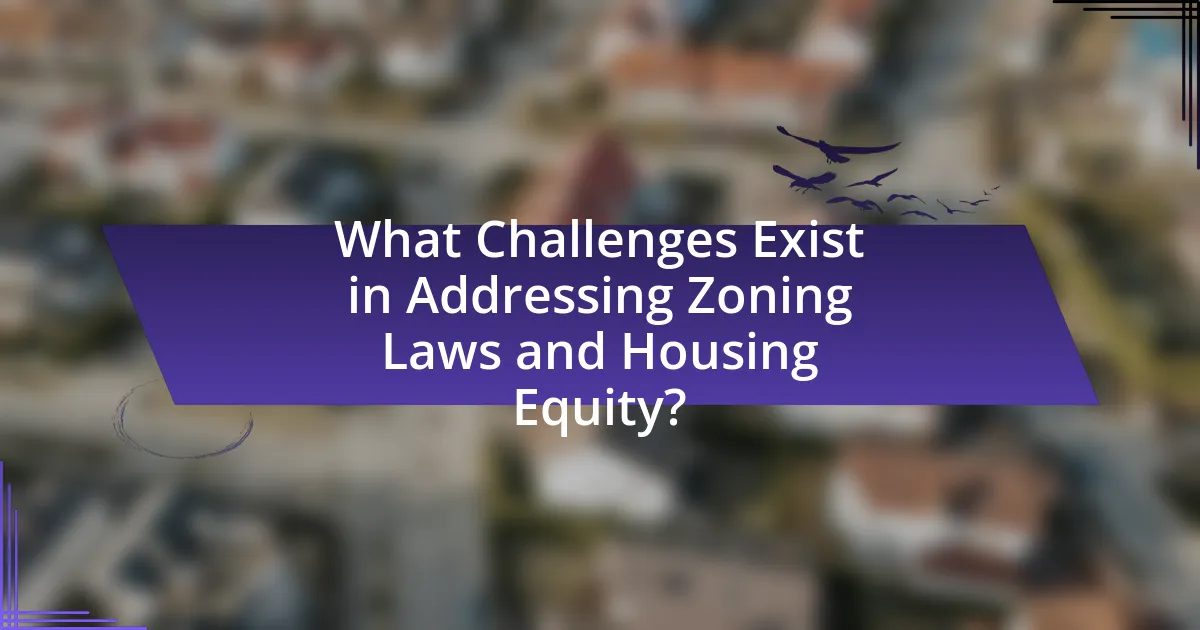
What Challenges Exist in Addressing Zoning Laws and Housing Equity?
Addressing zoning laws and housing equity faces significant challenges, primarily due to entrenched local interests and systemic inequalities. Local governments often prioritize property values and community preferences over equitable housing solutions, leading to exclusionary zoning practices that limit affordable housing options. For instance, a study by the National Low Income Housing Coalition highlights that restrictive zoning laws contribute to a shortage of affordable housing, disproportionately affecting low-income and minority communities. Additionally, the complexity of zoning regulations can create barriers for developers seeking to build affordable housing, as they navigate a patchwork of local ordinances that may favor single-family homes over multi-family units. These factors collectively hinder progress toward achieving housing equity, as they perpetuate segregation and limit access to essential resources for marginalized populations.
What are the political and social barriers to zoning reform?
Political and social barriers to zoning reform include entrenched local interests, resistance from existing homeowners, and systemic inequities in representation. Local governments often prioritize the preferences of current residents, who may oppose changes that could increase density or alter neighborhood character. This opposition is frequently fueled by fears of decreased property values and changes in community dynamics. Additionally, marginalized communities often lack adequate representation in zoning discussions, leading to policies that do not address their needs. Research indicates that these barriers perpetuate housing inequities, as zoning laws can restrict affordable housing development and maintain segregation.
How do community interests conflict with housing equity goals?
Community interests often conflict with housing equity goals by prioritizing local preferences over inclusive development. For instance, residents may resist affordable housing projects due to concerns about property values, neighborhood character, or increased traffic, which can lead to exclusionary zoning practices. Research from the Urban Institute indicates that such resistance can perpetuate segregation and limit access to housing for low-income families, undermining equity objectives. Consequently, community interests can create barriers to implementing policies aimed at promoting diverse and affordable housing options.
What role do developers play in shaping zoning laws?
Developers play a significant role in shaping zoning laws by influencing local government decisions through lobbying, community engagement, and participation in public hearings. Their financial investments and proposed projects often drive the need for changes in zoning regulations to accommodate new developments, which can lead to increased density or altered land use. For instance, developers may advocate for zoning variances or amendments that align with their project goals, thereby impacting the overall urban planning landscape. This influence is evident in many cities where developers have successfully lobbied for mixed-use zoning to facilitate higher-density housing, which can affect housing equity by either promoting affordable options or exacerbating gentrification.
How can stakeholders collaborate to improve housing equity?
Stakeholders can collaborate to improve housing equity by engaging in inclusive policy-making that addresses zoning laws and their impact on marginalized communities. Collaborative efforts can include forming coalitions among local governments, non-profit organizations, community groups, and private developers to advocate for zoning reforms that promote affordable housing. For instance, research from the Urban Institute highlights that inclusive zoning policies can increase the availability of affordable housing units, thereby reducing disparities in housing access. By sharing data, resources, and best practices, stakeholders can create comprehensive strategies that ensure equitable housing opportunities for all residents.
What strategies can local governments implement for equitable zoning?
Local governments can implement strategies for equitable zoning by adopting inclusionary zoning policies, which require a percentage of new developments to be affordable for low- and moderate-income households. This approach has been successfully utilized in cities like San Francisco, where inclusionary zoning has increased the availability of affordable housing units. Additionally, local governments can revise zoning codes to eliminate exclusionary practices, such as minimum lot sizes and single-family zoning, which disproportionately affect marginalized communities. For instance, Minneapolis has eliminated single-family zoning citywide, allowing for more diverse housing options. Furthermore, engaging in community outreach and participatory planning processes ensures that the voices of underrepresented populations are included in zoning decisions, fostering greater equity in housing development. These strategies collectively contribute to reducing housing disparities and promoting equitable access to housing.
How can community organizations advocate for zoning changes?
Community organizations can advocate for zoning changes by mobilizing residents, conducting research, and engaging in public forums. These organizations often gather community input to identify specific zoning issues affecting housing equity, such as exclusionary zoning practices that limit affordable housing options. By presenting data and case studies that highlight the benefits of inclusive zoning policies, they can effectively influence local government decisions. For instance, studies have shown that cities with more flexible zoning laws tend to have higher rates of affordable housing development, which supports the argument for change. Additionally, community organizations can collaborate with local policymakers to draft proposals that reflect community needs, ensuring that the voices of marginalized populations are heard in the zoning process.
What are practical steps for individuals to engage with zoning laws?
Individuals can engage with zoning laws by researching local zoning regulations, attending public meetings, and participating in community advocacy groups. Researching local zoning regulations allows individuals to understand the specific laws that govern land use in their area, which is essential for informed engagement. Attending public meetings provides a platform for individuals to voice their opinions and concerns regarding proposed zoning changes, fostering community involvement. Additionally, joining community advocacy groups enables individuals to collaborate with others who share similar interests in housing equity, amplifying their impact on local zoning decisions. These steps collectively empower individuals to influence zoning laws that affect housing equity in their communities.
